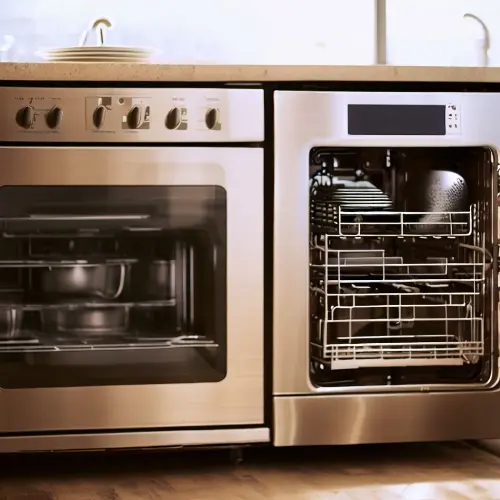Table of Contents
Can Dishwasher And Microwave Be On Same Circuit
No, a dishwasher and microwave should not be on the same electrical circuit to avoid overloading it. Having enough circuits to power all your kitchen appliances is crucial for operating them properly and avoiding electrical issues.
Two of the most common appliances in kitchens are dishwashers and microwaves. This raises the question – can these two appliances safely share the same circuit?
Understanding Household Electrical Circuits
To answer this question, it’s important to first understand some basics about household electrical systems and circuits.
Most homes have a main electrical service panel, known as the breaker box, which divides power into multiple circuits using breakers. Each circuit has a limited capacity and is wired to supply certain rooms or zones.
- Common circuits found in kitchens include:
- Small appliance circuits (rated 15-20 amps)
- Major appliance circuits (20 amps)
- Lighting, outlet, and miscellaneous circuits (15 amps)
Exceeding the capacity on any one circuit can trip the breaker, causing an outage until it’s reset. This protects the wiring from dangerous overheating.
Power Requirements for Dishwashers and Microwaves
To determine if a dishwasher and microwave can share a circuit, you need to look at their electrical requirements:
Dishwasher
- Voltage: 120V
- Amps: 6-10 (varies by model)
- Watts: 720-1200
Microwave
- Voltage: 120V
- Amps: 12-15
- Watts: 1000-1500
A typical dishwasher runs on a dedicated circuit rated for 15-20 amps. This provides enough power for safe operation.
Microwaves have higher amperage demands. Many require their own 20 amp appliance circuit. Some compact models may work on a 15-amp circuit.
Can They Go on the Same Circuit?
Whether a dishwasher and microwave can share a circuit depends on the total load.
- A 15 amp small appliance circuit may be overloaded by running both at once. This could trip the breaker.
- A 20 amp appliance circuit may support both, but there are a few considerations:
- The total amps used at one time could exceed 20 amps and trip the breaker.
- Even if it doesn’t trip, running both simultaneously may result in diminished performance.
- For optimal convenience and safety, most electricians recommend placing a microwave and dishwasher on separate, dedicated circuits.
A microwave should have its own 20 amp circuit. A dishwasher needs a 15-20 amp circuit, which could also include a garbage disposal and countertop outlets.
FAQs
Here are some frequently asked questions about running a dishwasher and microwave on the same circuit:
Can I put a dishwasher and microwave on one 20-amp circuit?
It’s not recommended. The combined amps may exceed the circuit capacity. It’s better to give each appliance its own dedicated circuit.
What happens if I use a dishwasher and microwave at the same time on one circuit?
This could overload the circuit, causing the breaker to trip. You’d lose power until you reset the breaker.
Can I put a dishwasher on the same circuit as my refrigerator?
Yes, a dishwasher and energy-efficient refrigerator can safely share a 15-20 amp small appliance circuit. Avoid outlets since they add more load.
What size breaker does a microwave need?
Most microwaves require a dedicated 20 amp appliance circuit. Check your model’s amp rating to be sure. Some smaller models can use 15 amp circuits.
Can I run a microwave and garbage disposal on one circuit?
No. A garbage disposal alone needs a 15 amp circuit. Combining it with a microwave risks overloading the circuit. Give each their own circuit.
How many amps does a dishwasher use when running?
Dishwashers typically use 6-10 amps of electricity while operating. The initial startup current draw may be slightly higher.
Can I plug in a microwave if it’s on the same circuit as my dishwasher?
It’s best not to. Microwaves and dishwashers have high electricity demands. Using both at once on one circuit can cause problems.
Key Takeaways
Most microwaves and dishwashers require their own dedicated 20-amp and 15-amp circuits respectively for optimal safety and performance.
Combining both on one 15 or 20-amp circuit often exceeds capacity, potentially tripping breakers or diminishing appliance performance.
Check your appliance manuals for exact electricity requirements before connecting to any circuit.
Consult an electrician if you need additional circuits installed to power all your kitchen appliances properly. Proper kitchen electrical wiring prevents problems.
Conclusion
While it is possible to wire a dishwasher and microwave to share a single 20-amp kitchen circuit in some cases, it is generally not recommended. The combined electric load when running simultaneously may overload the circuit. For best results, each appliance should have its own dedicated circuit sized to meet its electrical needs.
Checking amperages and wattages, and hiring an electrician for any new circuit installation, ensures proper wiring for safe operation. With adequate separate circuits in place, you can confidently use your dishwasher and microwave without any electrical concerns.

I’m Ian Welkins, a seasoned professional in the kitchen industry. My passion now drives me to provide invaluable insights into the world of top-notch kitchen products. With years of hands-on experience, I’m your go-to source for culinary excellence.











